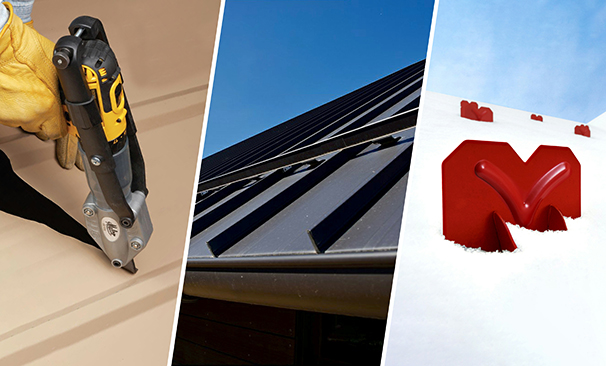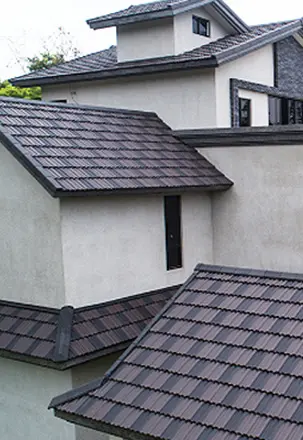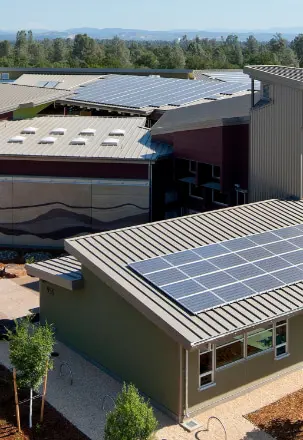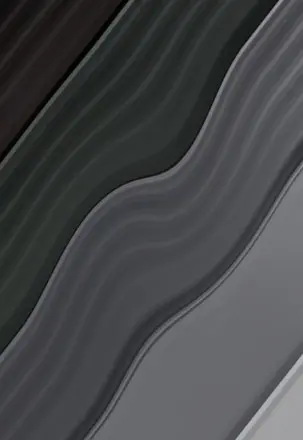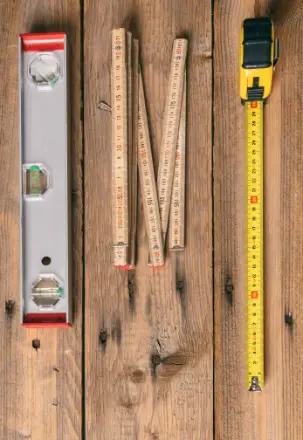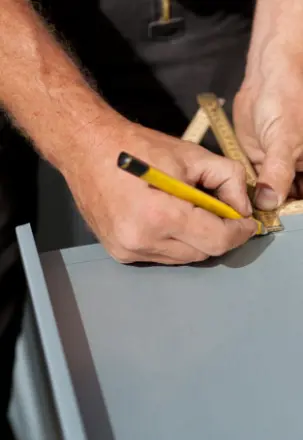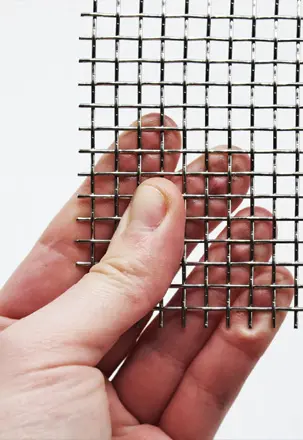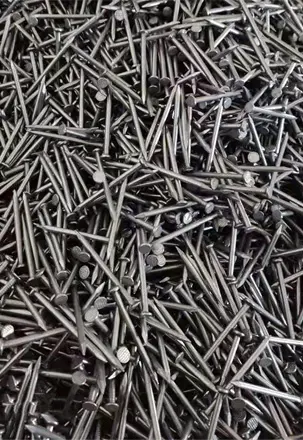Introduction
Camping is an adventure that connects us to nature, but it also requires the right gear to ensure comfort and safety. Among essential camping equipment, tarpaulins play a critical role. Whether used as a groundsheet, a rain shelter, a tent cover, or a makeshift canopy, the choice of tarp material can significantly affect your camping experience.
Two of the most common tarp materials are PVC (Polyvinyl Chloride) and PE (Polyethylene). While both provide weather protection, their properties, durability, cost, and usability differ greatly. Choosing the right one depends on your camping style, trip duration, budget, and environmental conditions.
In this article, we will break down PVC vs PE tarpaulins for camping in detail, covering:
- Material composition and properties.
- Strengths and weaknesses of each.
- Practical performance in camping situations.
- Long-term durability and environmental impact.
- Buying recommendations for different types of campers.
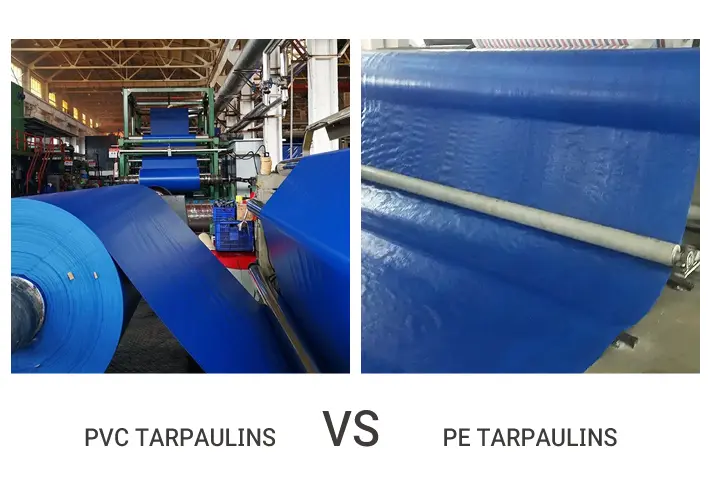
Understanding Tarpaulin Materials
Before comparing, let’s understand what PVC and PE tarpaulins are made of and how these materials impact their performance.
2.1 What is PVC Tarpaulin?
Composition:
PVC tarpaulin is made from a polyester base fabric coated with PVC resin on both sides. The polyester fabric gives it tensile strength, while the PVC coating provides waterproofing, abrasion resistance, and UV protection.
Manufacturing Process:
- Polyester yarn weaving – creates a strong base fabric.
- PVC coating – applied to both sides for waterproofing and weather resistance.
- Heat treatment – fuses the coating, creating a durable, flexible material.
Key Characteristics:
- Heavy-duty performance: Thickness ranges from 0.35mm to 1.2mm, weight from 500gsm to 900gsm.
- Long-lasting waterproofing: Suitable for continuous outdoor exposure.
- Weather resistance: Works well in rain, snow, and high UV conditions.
- Flexibility: Maintains flexibility even in sub-zero temperatures.
Common Camping Uses:
- All-weather tent covers.
- Canopy shelters in long-term camps.
- Ground protection in wet or muddy areas.
- Basecamp covers in mountaineering expeditions.
2.2 What is PE Tarpaulin?
Composition:
PE tarpaulin is made from woven polyethylene fabric laminated with LDPE (Low-Density Polyethylene) or HDPE (High-Density Polyethylene) film on both sides.
Manufacturing Process:
- Extrusion of polyethylene strips.
- Weaving into a mesh fabric.
- Lamination with PE film for waterproofing.
Key Characteristics:
- Lightweight: Weight ranges from 90gsm to 300gsm.
- Good waterproofing: Suitable for light to medium rain.
- Portability: Easy to fold and carry.
- Budget-friendly: Lower production cost.
Common Camping Uses:
- Temporary rain shelters.
- Groundsheet under tents.
- Lightweight canopy for shade.
- Emergency weather protection.
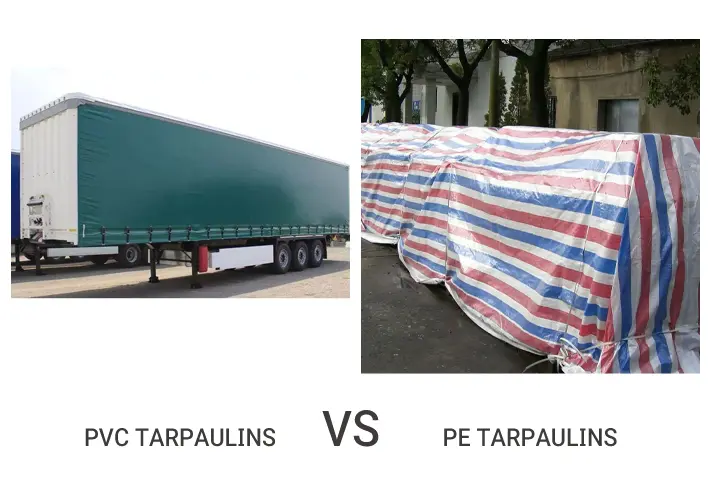
Detailed Comparison of PVC vs PE Tarpaulins for Camping
| Feature | PVC Tarpaulin | PE Tarpaulin |
|---|---|---|
| Weight | Heavy (500–900gsm) | Light (90–300gsm) |
| Waterproof Performance | 100% waterproof, long-term performance | Waterproof, but coating can degrade faster |
| UV Resistance | Strong, long-lasting | Requires UV treatment, shorter lifespan in sun |
| Tear Strength | High tensile & tear resistance | Moderate tear resistance |
| Cold Weather Resistance | Flexible in extreme cold | Can become brittle in freezing temperatures |
| Heat Resistance | Better heat stability | May deform under prolonged high heat |
| Portability | Less portable due to weight | Very portable |
| Lifespan | 5–10 years with care | 1–3 years with care |
| Cost | Higher price | Lower price |
| Eco Impact | Harder to recycle | Easier to recycle |
Advantages and Disadvantages
4.1 PVC Tarpaulin
Advantages:
- Exceptional durability – handles rough terrain and heavy loads.
- Superior waterproofing – perfect for heavy rain and snow.
- UV resistance – maintains integrity in sunny environments.
- Cold flexibility – doesn’t crack in sub-zero conditions.
- Long service life – cost-effective for long-term use.
Disadvantages:
- Heavy and bulky – less ideal for backpacking trips.
- Higher cost – initial investment is higher.
- Recycling challenges – not as eco-friendly.
4.2 PE Tarpaulin
Advantages:
- Lightweight – easy to carry and set up.
- Low cost – affordable for budget-conscious campers.
- Good water protection – suitable for short-term use.
- More recyclable – better environmental footprint.
Disadvantages:
- Shorter lifespan – wears out faster under sunlight and stress.
- Weaker tear resistance – prone to damage in strong winds.
- Cold brittleness – can crack in freezing temperatures.
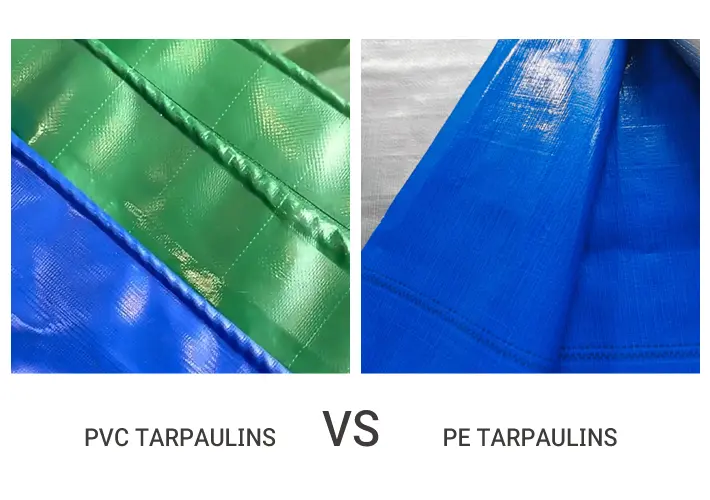
Which One is Better for Camping?
5.1 For Short-Term or Occasional Camping
If you camp once or twice a year for a weekend, a PE tarpaulin is usually sufficient. It’s lightweight, easy to carry, and inexpensive.
5.2 For Long-Term or Extreme Weather Camping
If you are on multi-week camping trips or in harsh climates (mountains, snow, desert), a PVC tarpaulin is the better investment due to its superior weather resistance and durability.
5.3 Climate Considerations
- Hot, sunny climates: PVC is better due to stronger UV resistance.
- Cold, snowy climates: PVC remains flexible in freezing weather.
- Mild climates: PE is more portable and cost-effective.
Practical Considerations Before Buying
When choosing between PVC and PE tarpaulins for camping, consider:
- Weight vs. durability – Is portability more important than strength?
- Budget – Are you looking for the cheapest option or the longest-lasting?
- Frequency of use – Regular campers benefit from PVC, occasional campers from PE.
- Storage space – PVC tarps are bulkier when packed.
- Camping style – Backpacking favors PE, basecamping favors PVC.
Case Studies
Case 1: Mountain Expedition Campers
A mountaineering team sets up a basecamp for 30 days at 4,500m altitude. They choose PVC tarpaulins for tent covers and kitchen shelters because:
- High UV exposure.
- Heavy snow loads.
- Need for tear resistance in high winds.
Result: Tarps remain intact throughout the expedition, reusable for future trips.
Case 2: Beachside Weekend Campers
A family goes camping at a coastal campsite for 3 days. They use PE tarpaulins for:
- Shade canopy.
- Groundsheet under the tent.
- Light rain protection.
Result: PE tarps perform well and are easy to clean and pack after the trip.
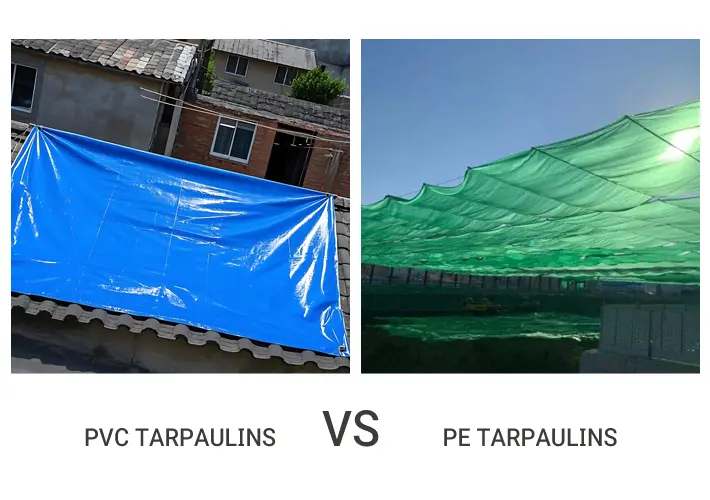
Maintenance Tips for Both PVC and PE Tarpaulins
Cleaning
- Use mild soap and water.
- Avoid harsh chemicals that degrade the coating.
Storage
- Dry completely before folding.
- Store in a cool, dry place away from sunlight.
Repairs
- Small tears: Use patch kits (PVC patches for PVC tarps, PE patches for PE tarps).
- Larger damage: Professional repair or replacement.
UV Protection
- For PE tarps, consider applying UV-protective spray to extend lifespan.
Environmental Impact and Sustainability
- PVC tarps last longer but are harder to recycle due to mixed materials.
- PE tarps have a shorter lifespan but can be recycled more easily into new products.
- From a sustainability perspective, choosing a tarp that lasts longer reduces overall waste.
Conclusion & Recommendations
PVC tarpaulin is the right choice if you need:
- Long-term durability.
- Heavy-duty waterproofing.
- Protection in extreme climates.
PE tarpaulin is the right choice if you need:
- Lightweight portability.
- Affordable short-term protection.
- Easy setup for casual camping.
Final Tip:
If you are a frequent camper or camping in harsh conditions, invest in a PVC tarp. If you are an occasional camper or backpacker, a PE tarp will be more practical.
About Us – Your Trusted Tarpaulin Manufacturer in China
We are a professional tarpaulin factory in China, specializing in the production of PVC tarpaulins, PE tarpaulins, and customized camping covers for the global market.
With advanced coating and weaving equipment, strict quality control, and export experience to over 50 countries, we ensure our products meet international waterproofing, UV resistance, and durability standards.
Whether you are a wholesaler, distributor, or brand owner, we can offer:
- Factory-direct pricing for bulk orders.
- Customized sizes, colors, and printing to match your brand.
- Fast production and shipping to meet your schedule.
- OEM & ODM services for your market needs.
Contact us today to get a free sample and quotation!


